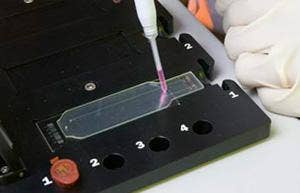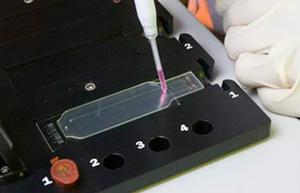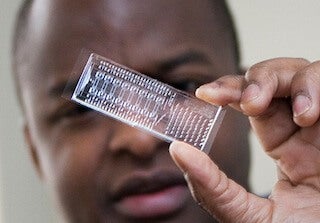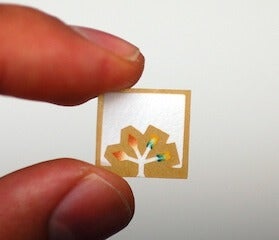3 Ground-Breaking Miniature Biosensors To Change World Medicine

Share
Fast, small and cheap. No, I’m not describing the latest compact sports cars, but rather the most recent group of biosensors that can detect a variety of biological agents. Over the past few years, several research teams have developed increasingly smaller and cheaper biosensors with improved detection capabilities and faster turnaround times. We have already described a device that can attach to an iPhone and detect potentially dangerous chemicals. In this post, we will focus on devices that have been designed to detect biological compounds from a variety of sources. So whether you are a doctor diagnosing patients in the rural areas of Africa or a Homeland Security agent working to thwart an act of bioterrorism, one of these little devices should be your sidekick.
Lawrence Livermore Microbial Detection Array (LLMDA)
A research team from the Lawrence Livermore National Laboratory has developed a miniature biosensor that is capable of identifying microbes in a sample within 24 hours. The original one-inch wide, 3-inch long Lawrence Livermore Microbial Detection Array (LLMDA) can identify approximately 2,000 viruses and 900 bacteria. However, a more advanced version currently under development will be able to detect about 5,700 viruses, thousands of bacteria and fungi as well as about 75 protozoa. This next-generation version of the LLMDA contains probes that are specific for approximately 2.1 million different sequences derived from the various microbes mentioned above (some microbes have multiple probes, thus there are not 2.1 million different microbes that can be detected). After extracting DNA or RNA from a sample, it is applied to the LLMDA. Any probe that detects its specific sequence will fluoresce and a scanner reads this fluorescence. The LLMDA has already demonstrated its capabilities. Scientists at the Blood Systems Research Institute in San Francisco used it to screen GlaxoSmithKline’s Rotarix vaccine that is used to prevent childhood diarrhea. To their surprise, they found a contamination by porcine circovirus, a pig virus. Although it turns out to be harmless to humans, the LLMDA was able to identify this relatively rare virus that should not have been there in the first place. Expect more from this nifty device in the coming years.
Frederick Balagaddé’s Bio-lab on a Microchip
Frederick Balagaddé, another scientist at the Lawrence Livermore National Laboratory, has developed a microfluidics-based detection chip which functions to not only detect HIV, but also determine viral load in patients. Described by Balagaddé in a recent TED talk (see below), this chip seems poised to make a big difference in developing countries. Small enough to fit in the palm of your hand, this device is essentially a miniaturized version of a complete diagnostic experiment. Amazingly, one chip can diagnose 100 patients AND determine their viral load within 4 hours! As Balagaddé mentions in the video, treatment is not the only concern when it comes to alleviating disease burdens in developing countries. A correct and timely diagnosis is critical to ensure an appropriate therapeutic response. It is not hard to imagine that this technology could soon be used to diagnose other common and debilitating diseases in sub-Saharan Africa, including tuberculosis and malaria. Further, maybe a device could even be developed that could test for all of these and other diseases simultaneously. This would truly be a monumental development and coupled with access to efficacious drugs, could begin to turn the tide against these horrible diseases that kill millions of people each year.
Be Part of the Future
Sign up to receive top stories about groundbreaking technologies and visionary thinkers from SingularityHub.


George Whitesides’s Postage-Sized Laboratory
George Whitesides, a professor of chemistry at Harvard University, has developed an even more simplistic biosensor. Made only of paper and a water-repellant polymer, this biosensor can be used for detecting various biological compounds that can signify health or disease. An example would be the concentration of glucose in the blood. So how does it work? Each piece of diagnostic paper contains compounds that react with the molecule of interest. After applying the biological sample (blood, urine, saliva, etc), the paper wicks it through channels formed by the polymer until it reaches the reactive compound. The presence of a particular molecule in the sample results in a color change for easy diagnosis by anyone. Several tests can even be placed on one piece of paper so multiple molecules can be monitored from one sample. In order to facilitate dissemination of these papers to areas with the greatest need, Whitesides has started a nonprofit organization called Diagnostics for All and has received early funding from the Bill and Melinda Gates Foundation. Currently, the organization is working to deliver diagnostic papers that will detect the levels of two key liver enzymes, AST (aspartate transaminase) and ALT (alanine transaminase). These enzymes are found in high levels in the blood of patients experiencing liver toxicity after taking antiretroviral drugs.
All of these devices are designed to simplify and speed up detection of microbes or other important biological molecules. With their small size, ease of use, and low cost, biosensors should find wide use in 3 main areas. First, they will be useful for diagnosis of disease in the Third World where access to clinics is not realistic for many people. Second, security agents who are on the hunt for potential biological weapons can use them in any environment. And finally, they will allow anyone with an interest in participating in citizen science to do so. For example, average citizens can monitor the presence of specific compounds or microbes in a local body of water. Or anyone can monitor their health and alert their doctor for further tests if they find elevated levels of a particular compound. Hopefully in the near future, we will see more and more of these biosensors being utilized around the world!
[image credits: Jacqueline McBride/NEWSLINE, Whitesides Lab]
[video credits: TED]
[Source: TED, Lawrence Livermore National Laboratory, Hansjörg Wyss Institute for Biologically Inspired Engineering at Harvard University]
Related Articles

This Portable Wind Turbine Is the Size of a Water Bottle and Charges Devices in Under an Hour

Mojo Vision’s New Contact Lens Brings Seamless Augmented Reality a Step Closer
The Weird, the Wacky, the Just Plain Cool: Best of CES 2020
What we’re reading


